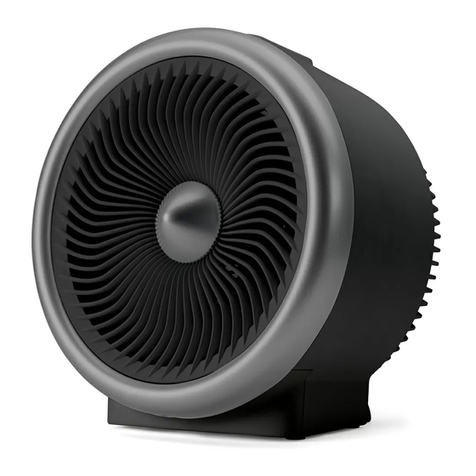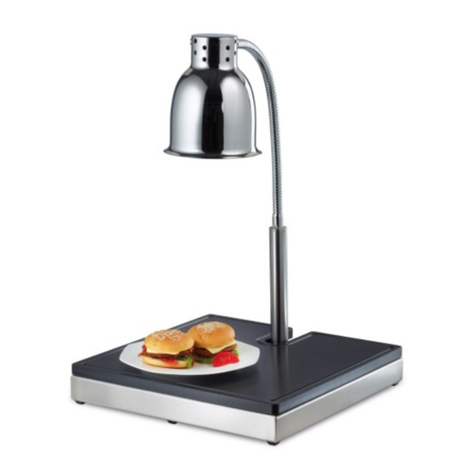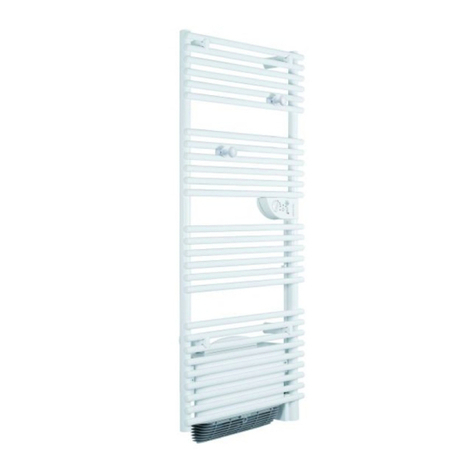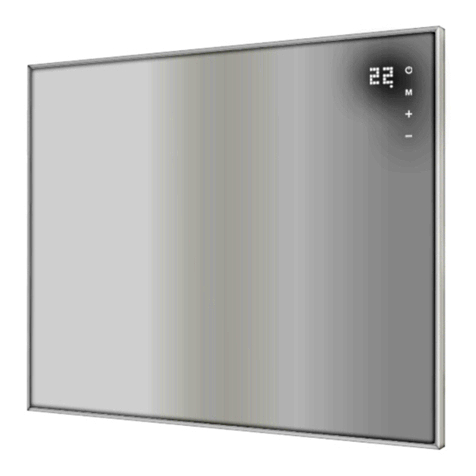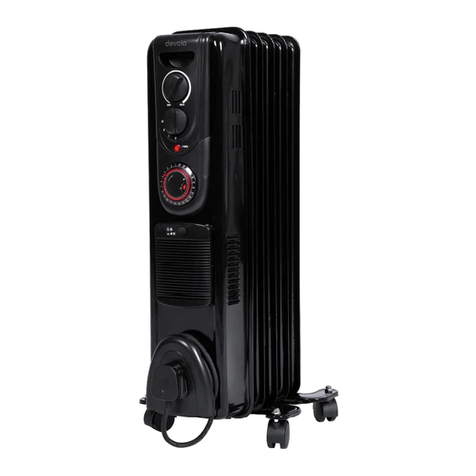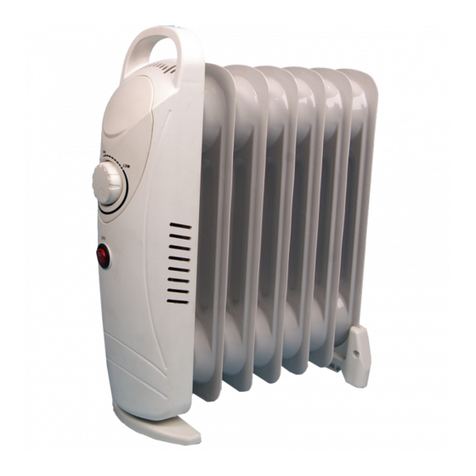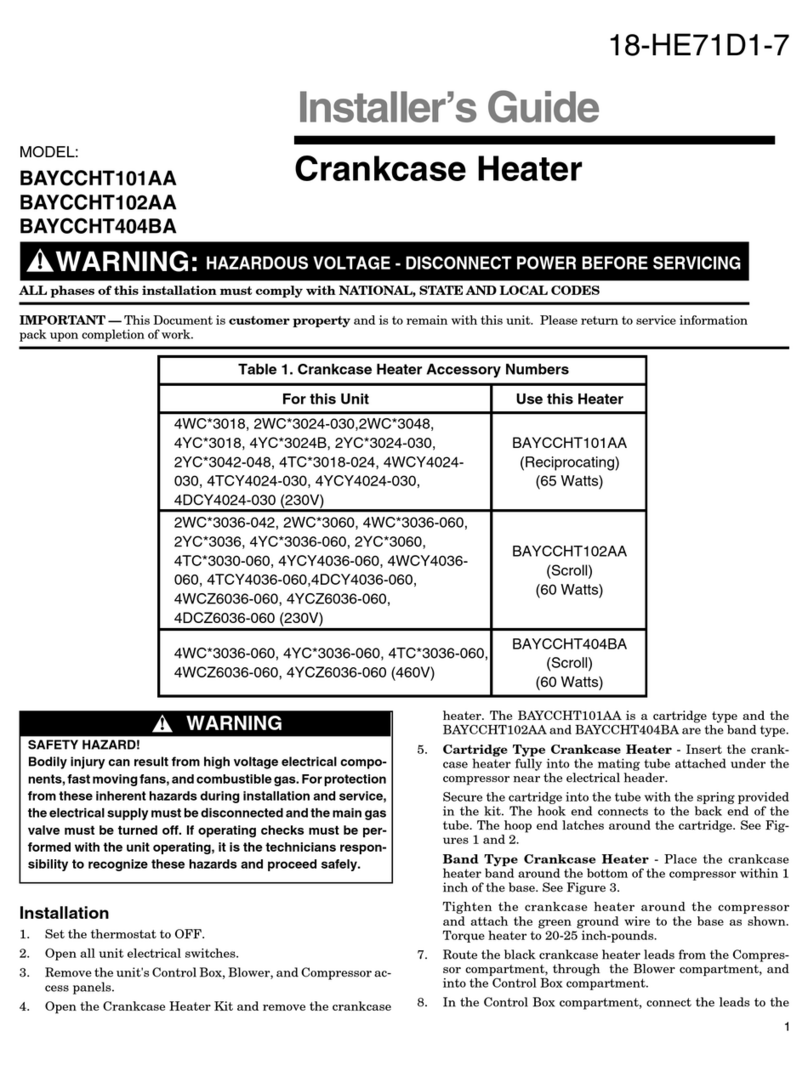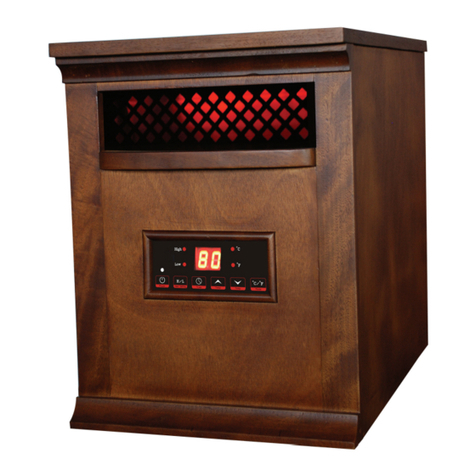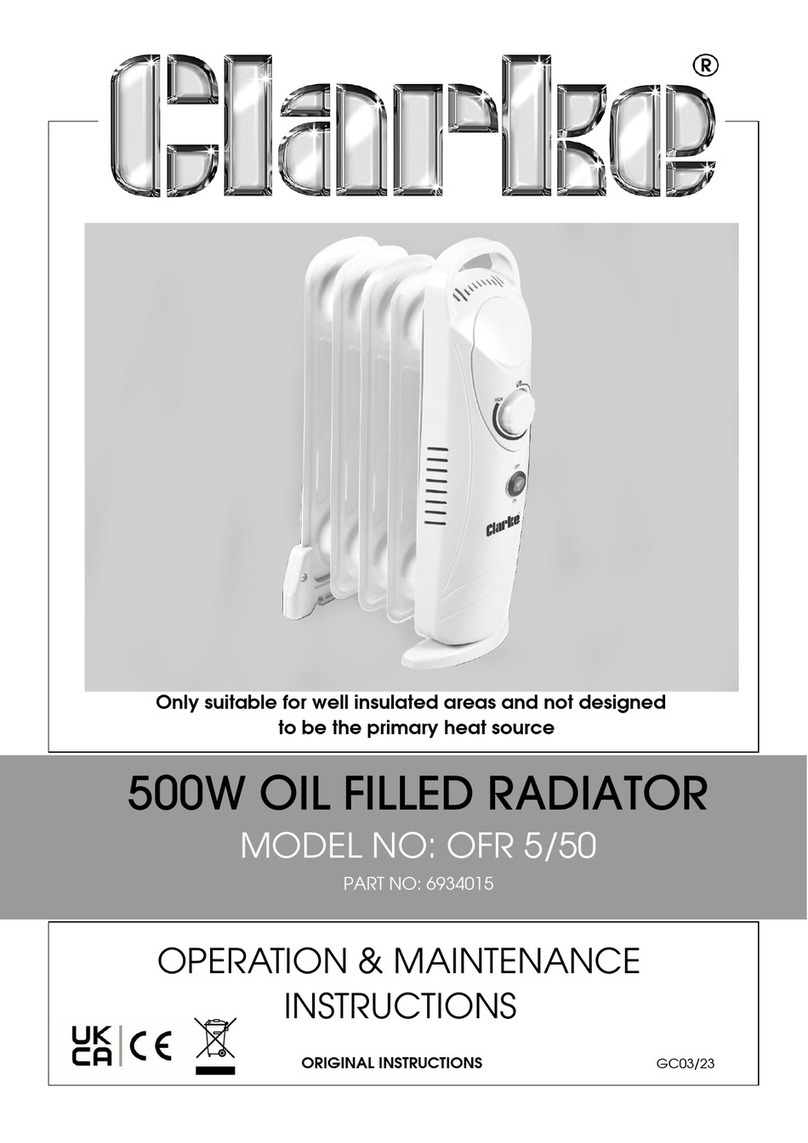BlueRhino GWU9850F / 35554A User manual

Outdoor LP Gas Patio Heater
Model No. GWU9850F / 35554 (A & B)
OWNER’S MANUAL
WARNING
FOR YOUR SAFETY:
For Outdoor Use Only (outside any enclosure)
WARNING
FOR YOUR SAFETY:
WIf the information in this manual is not
followed exactly, a fire or explosion may
result causing property damage, personal
injury or loss of life.
WWHAT TO DO IF YOU SMELL GAS:
• Do NOT try lighting any appliance.
• Do NOT touch any electrical switch; do
NOT use any phone in your building.
• Immediately call your gas supplier from a
neighbor’s phone.
• Follow the gas supplier’s instructions.
• If you cannot reach your gas supplier, call
the fire department.
WInstallation and service must be performed
by a qualified installer, service agency or
gas supplier.
WSave these instructions for future
reference.
WIf you are assembling this unit for someone
else, give this manual to him or her to read
and save for future reference.
WARNING
FOR YOUR SAFETY:
Improper installation, adjustment,
alteration, service or maintenance can
cause injury or property damage.
Read the installation, operation and
maintenance instructions thoroughly before
installing or servicing this equipment.
DANGER
If you smell gas:
1. Shut off gas to appliance.
2. Extinguish any open flame.
3. If odor continues, keep away from the
appliance and immediately call your gas
supplier or your fire department.
WARNING
FOR YOUR SAFETY:
1. Do NOT store or use gasoline or other
flammable vapors or liquids in the vicinity of
this or any other appliance.
2. An LP-cylinder not connected for use shall
not be stored in the vicinity of this or any
other appliance.
DANGER
Never operate this appliance unattended while
in operation.
Table of Contents
Important Safeguards ...........................................................Page 2
Expanded View and Hardware......................................................... 4
Assembly Instructions............................................................... 5
Installing LP Gas Tank............................................................... 8
Operating Instructions............................................................... 8
Cleaning and Care ................................................................. 9
Product Registration ............................................................... 10
Replacement Parts . . . . . . . . . . . . . . . . . . . . . . . . . . . . . . . . . . . . . . . . . . . . . . . . . . . . . . . . . . . . . . . . 10
Limited Warranty ................................................................ 10
Specifications.................................................................... 10
Troubleshooting .................................................................. 11
The use and installation must conform with local codes or, in the absence of local codes, with either the
National Fuel Gas Code, ANSI Z223.1/NFPA 54, Natural Gas and Propane Installation Code, CSA B149.1,
or Propane Storage and Handling Code, B149.2, or the Standard for Recreational Vehicles, ANSI A 119.2/
NFPA 1192, and CSA Z240 RV Series, Recreational Vehicle Code, as applicable.
THIS INSTRUCTION BOOKLET CONTAINS IMPORTANT SAFETY INFORMATION. PLEASE READ AND KEEP
FOR FUTURE REFERENCE.
If you are assembling this unit for someone else, give this manual to him or her to read and save for
future reference.
California Proposition 65: Combustion by-products produced when using this product contain chemicals
known to the State of California to cause cancer, birth defects, and other reproductive harm.
California Proposition 65: Wash your hands after handling this product.
California Proposition 65: Handling the brass material on this product exposes you to lead, a chemical
known to the State of California to cause cancer, birth defects, or other reproductive harm.
Made from 75% Bagasse
(environmentally friendly sugar
cane pulp by-product)
Manufactured in China for: Blue Rhino Global Sourcing, Inc.
Winston-Salem, NC 27105 USA • 1.800.762.1142 • BlueRhino.com
© Blue Rhino Global Sourcing, Inc.
Frontgate®is a Registered Trademark of Frontgate, Inc. GWU9850F-EF-OM-F107
CARBON MONOXIDE HAZARD
• This appliance can produce carbon monoxide which has
no odor.
• Using it in an enclosed space can kill you.
• Never use this appliance in an enclosed space such as a
camper, tent, car or home.
DANGER

Outdoor LP Gas Heater
Model No. GWU9850F / 35554 (A & B)
2
WThis heater is for outdoor use only, and should not be used in a building,
garage or any other enclosed area.
WAlways maintain at least 36 inch clearance (top and side) from
combustible materials. Do NOT use this appliance under any type of
overhang or roof.
WFor residential use only. This heater is NOT for commercial use.
WDo NOT operate, light or use this appliance within ten feet (3.05 m) of
walls, structures or buildings.
WThis heater is not intended for and should never be used as an indoor
heater. TOXIC fumes can accumulate and cause asphyxiation.
WThis heater is safety certified for use in the United States and/or Canada
only. Do NOT modify for use in any other location. Modification will
result in a safety hazard and will void your warranty.
WThis heater, from the factory, is for use with liquid propane (LP) gas only.
The conversion to or attempted use of natural gas in this LP gas heater
is dangerous, may cause bodily harm and will void your warranty.
WApartment dwellers: Check with management to learn the requirements
and fire codes for using an LP gas heater in your apartment complex.
If allowed, use outside on the ground floor with a ten foot (3.05 m)
clearance from any structure. Do NOT use on or under balconies.
WLP gas characteristics:
a. LP gas is flammable and hazardous if handled improperly. Become
aware of the characteristics before using any LP gas product.
b. LP gas is explosive under pressure, heavier than air, and settles/
pools in low areas.
c. LP gas in its natural state has no odor. For your safety, an odorant is
added that smells like rotten cabbage.
d. Contact with LP gas can cause freeze burns to skin.
WLP gas cylinder needed to operate. Only cylinders marked “propane”
may be used.
a. The LP gas cylinder must be constructed and marked in accordance
with the Specifications for LP-gas Cylinders of the U.S. Department
of Transportation (D.O.T.) or the National Standard of Canada, CAN/
CSA-B339, Cylinders, Spheres and Tubes for the Transportation of
Dangerous Goods; and Commission.
b. LP gas cylinder must be arranged for vapor withdrawal.
c. The LP gas cylinder must have a listed overfilling prevention device
(OPD).
d. Only use LP gas cylinders equipped with a cylinder connection
device compatible with the connection for outdoor cooking
appliances.
e. The LP gas cylinder must have a cylinder collar to protect the
cylinder valve.
f. Never use an LP gas cylinder with a damaged body, valve, collar or
footing.
g. Dented or rusted LP gas cylinders may be hazardous and should be
checked by your LP gas supplier prior to use.
h. The LP gas cylinder should not be dropped or handled roughly.
i. LP gas cylinders must be stored outdoors out of the reach of
children and must not be stored in a building, garage or any
other enclosed area. Your cylinder must never be stored where
temperatures can reach over 125°F.
j. Do NOT insert any tool or foreign object into the valve outlet or
safety relief valve. You may damage the valve and cause a leak.
Leaking propane may result in an explosion, fire, severe personal
injury or death.
k. Do NOT block holes in sides or back of the heater.
l. Never keep an LP gas cylinder in a hot car or trunk. Heat will cause
the gas pressure to increase, which may open the relief valve and
allow gas to escape.
m. Place dust cap on cylinder valve outlet whenever the cylinder is not
in use. Only install the type of dust cap on the cylinder valve outlet
that is provided with the cylinder valve. Other types of caps or plugs
may result in leakage of propane.
n. If heater is not in use, the gas must be turned off at the supply
cylinder and disconnected.
o. Do NOT store a spare LP gas cylinder under or near this appliance.
p. NEVER fill the cylinder beyond 80 percent full.
q. A fire causing serious injury or damage to property may occur if the
above is not followed exactly.
WNever attempt to attach this heater to the self-contained LP gas system
of a camper trailer, motor home or house.
WNever use charcoal, lighter fluid, lava rocks, gasoline, kerosene or
alcohol with this product.
WYour heater has been checked at all factory connections for leaks.
Recheck all connections as described in the “Operating Instructions”
section, as shipping can loosen connections.
WCheck for leaks even if your unit was assembled by someone else.
WDo NOT operate if a gas leak is present. Gas leaks may cause a fire or
explosion.
WYou must follow all instructions in “Checking for Leaks” section before
operating. To prevent fire or explosion hazard when testing for a leak:
a. Always perform a leak test before lighting the heater and each time
the cylinder is connected for use.
b. No smoking. Do NOT use or permit sources of ignition in the area
while conducting a leak test.
c. Conduct the leak test outdoors in a well-ventilated area.
d. Do NOT use matches, lighters, or a flame to check for leaks.
e. The use of alcohol, prescription or non-prescription drugs may
impair the consumer’s ability to properly assemble or safely operate
the appliance.
f. Strong odors, colds, sinus congestion, etc. may prevent the
detection of propane. Use caution and common sense when testing
for leaks.
g. Do NOT use heater until any and all leaks are corrected. If you are
unable to stop a leak, disconnect the LP gas supply. Call a gas
appliance serviceman or your local LP gas supplier.
WThis heater is designed to operate at an inlet pressure of 11 inches
water column.
WDo NOT store or use gasoline or other flammable liquids or vapors
within 25 feet (7.62 m) of this appliance.
WDo NOT use in an explosive atmosphere. Keep heater area clear and free
from combustible materials, gasoline and other flammable vapors and
liquids.
WIt is essential to keep the heater’s valve compartment, burners and
circulating air passages clean.
WInspect heater before each use.
WDo NOT alter heater in any manner. Any alteration will void your
warranty.
WDo NOT use the heater unless it is COMPLETELY assembled and all parts
are securely fastened and tightened.
WDo NOT build this model of heater in any built-in or slide-in
construction. Ignoring this warning could cause a fire or an explosion
that can damage property and cause serious bodily injury or death.
WThis heater should be thoroughly cleaned and inspected on a regular
basis.
WClean and inspect the hose before each use of the appliance. If there
is evidence of abrasion, wear, cuts or leaks, the hose must be replaced
prior to operation.
WUse only the regulator and hose assembly provided. Use only the
replacement regulator and hose assembly specified by Blue Rhino
Global Sourcing, Inc.
WUse only Blue Rhino Global Sourcing, Inc. factory-authorized parts. The
use of any part that is not factory-authorized can be dangerous and will
void your warranty.
WDANGER: Failure to follow the dangers, warnings and cautions in this manual may result in serious bodily injury or death, or in a fire or an explosion
causing damage to property.
WWARNINGS:
Important Safeguards

Need help? 1.800.762.1142
Do not return to place of purchase.
Replacement Parts
parts.BlueRhino.com
1.800.762.1142
3
WDo NOT operate this appliance without reading “Operating Instructions”
in this manual.
WDome and burner are extremely hot to the touch during operation. Never
touch the dome or burner while the heater is operating. The surface of
heater’s emitter can reach temperatures approaching 1600ºF.
WDo NOT touch metal parts of heater until they have completely cooled
to avoid burns, unless you are wearing protective gear (pot holders,
gloves, BBQ mittens, etc.).
WDo NOT install or use in or on boats or recreational vehicles.
WWhen using, fire extinguishing materials should be readily accessible.
WDo NOT use heater in winds exceeding 10 mph (16.1 km/h).
WDo NOT leave a lit heater unattended. Keep children and pets away from
heater at all times.
WDo NOT place anything on the heater while the appliance is in operation.
WKeep sprinklers and other water sources away from burner and
controls.
WDo NOT hang clothing or other flammable materials either on or near
heater.
WNever cover the heater shroud while LP gas tank is enclosed.
WDo NOT attempt to move heater when in use. Allow the heater to cool
before moving or storing.
WLP gas cylinder must be properly disconnected and removed prior to
moving this heater.
WStorage of heater indoors is permissible only if the cylinder is
disconnected, removed from the heater and properly stored outdoors.
WDo NOT attempt to disconnect the gas regulator from the cylinder or any
gas fitting while the heater is in use.
WAlways place your heater on a hard, non-combustible, level surface. An
asphalt or blacktop surface may not be acceptable for this purpose.
WMove gas hoses as far away as possible from hot surfaces and dripping
hot grease.
WKeep all electrical cords away from a hot heater.
WAfter a period of storage and/or nonuse, check for leaks, burner
obstructions and inspect for any abrasion, wear or cuts to the hose.
WIf at any time you are unable to light burner and you smell gas, turn off
and wait 5 minutes to allow gas to dissipate before attempting to light
heater.
WFailure to not wait 5 minutes to allow the gas to clear if the heater does
not light may result in an explosive flame-up.
WBe careful when attempting to manually ignite this heater. Holding in
the control knob for more than 10 seconds before igniting the gas will
cause a ball of flame upon ignition.
WAvoid inhaling fumes emitted from the heater’s first use. Smoke and
odor from the burning of oils used in manufacturing will appear. Both
smoke and odor will dissipate after approximately 30 minutes. The
heater should NOT produce thick black smoke.
WUse protective gloves when assembling this product.
WDo NOT force parts together as this can result in personal injury or
damage to the product.
WDeath, serious injury or damage to property may occur if the above is
not followed exactly.
Important Safeguards

Outdoor LP Gas Heater
Model No. GWU9850F / 35554 (A & B)
4
Tools Required for Assembly (Not Included)
7/16” Wrench
5/16’’ Socket and Socket Wrench
5/16"
#2 Phillips Head Screwdriver
Parts List
1Upper Dome 56-01-614
2Lower Dome 56-01-615
3Emitter Top* 56-01-616
4Emitter Screen* 56-01-617
5Burner* 56-01-618
6Pilot Heat Shield* 56-01-619
7Bottom Plate 56-01-620
8Valve Support Bracket* 56-01-621
9Pilot Assembly* 56-01-127
10 Burner Orifice* 56-01-131
11 Electronic Igniter* 56-01-142
12 Igniter Button* 56-01-622
13 Control Knob* 56-01-156
14 Access Panel* 56-01-623
15 Valve* 56-01-144
16 Tip Switch* 56-01-019
17 Gas Line 56-01-190
18 Engine Cover* 56-01-624
19 Control Panel Door* 56-01-625
20 Upper Cap 56-01-626
21 Pole 56-01-627
22 Lower Cap 56-01-628
23 Shroud Cap 56-01-629
24 Regulator/Hose Assembly 56-01-355
25 Shroud Back 56-01-630
26 Shroud Front 56-01-631
27 Tank Retainer Wire 56-01-632
28 Wheel Assembly 56-01-633
29 Base 56-01-634
30 Weight Plate 56-01-635
* Pre Assembled
Expanded View
Hardware
AScrew M6x25 Black Zinc Plated Philips Truss Head 4 pcs
BScrew M6x40 Black Zinc Plated Philips Truss Head 4 pcs
CBolt Nickel Plated 3 pcs
DBolt Nickel Plated 3 pcs
EBolt Nickel Plated 4 pcs
FNut M5 Stainless Steel 3 pcs
GNut M6 Black Zinc Plated 4 pcs
HWasher ø5 Zinc Plated 3 pcs
IAA Battery AA Battery 1 pc
2
4
21
30
29
25
7
8
1
3
19
23
26
28
5
20
18
22
910
15
16
17
24
11 12
13
14
6
27

Need help? 1.800.762.1142
Do not return to place of purchase.
Replacement Parts
parts.BlueRhino.com
1.800.762.1142
5
1
DO NOT RETURN TO PLACE OF PURCHASE.
For assistance, call 1.800.762.1142 toll-free. Please have
your owner’s manual and model number available for
reference.
Note: The model number is printed on a label which can be found on
the back or side of the valve housing.
Assembly Tips:
1. Select an area where you will assemble this product. To
protect components, choose a smooth surface that’s free of
cracks or openings.
2. Spread out all parts.
3. Tighten all hardware connections by hand first. Then, before
completing each step, go back and fully tighten all hardware.
Be careful not to over-tighten. That could damage surfaces or
strip threads.
4. For best results, complete each step in the order presented.
To complete assembly you will need:
• (1) Leak detection solution (instructions on how to make the
solution are included in the “Operating Instructions” section of
this manual).
• (1) Precision-filled LP gas grill tank with Acme Type 1 external
threaded valve connection (standard grill size) (not included).
Typical assembly is approximately one hour.
Assembly Instructions
3
Attach Pole
Ex 4
4
Place Caps
2
Attach Base
Bx 4 Gx 4

Outdoor LP Gas Heater
Model No. GWU9850F / 35554 (A & B)
6
Assembly Instructions (continued)
5
Attach Engine Assembly
Ax 4
6
Secure Upper Cap
Note: Upper cap must align with the notch on the engine assembly and lock into
position.
8
Attach Lower Dome
Dx 3
7
Attach Bolts
Cx 3

Need help? 1.800.762.1142
Do not return to place of purchase.
Replacement Parts
parts.BlueRhino.com
1.800.762.1142
7
Assembly Instructions (continued)
11
Attach Regulator/Hose Assembly
WWARNING: ALWAYS perform a leak check per “Checking for
Leaks” section.
10
Insert Battery
Ix 1
9
Attach Upper Dome
Fx 3 Hx 3
12
Attach Tank Retainer Wire
Attach Shroud Front

Outdoor LP Gas Heater
Model No. GWU9850F / 35554 (A & B)
8
Operating Instructions
Checking for Leaks
Tank/Gas Line Connection
1. Make 2-3 oz. of leak detection solution by mixing
one part liquid dishwashing soap with three parts
water.
2. Make sure control knobs are in the “ OFF”
position (Figure 3).
3. Connect LP gas tank per “Installing LP Gas Tank”
section.
4. Turn LP gas tank valve to “OPEN.”
5. Spoon several drops of solution, or use a squirt
bottle, at all “X” locations (Figures 1 and 2).
a. If any bubbles appear, turn LP gas tank valve to
“CLOSED,” reconnect and re-test.
b. If you continue to see bubbles after several
attempts, turn LP gas tank valve to “CLOSED”
and disconnect LP gas tank, per “Disconnecting
LP Gas Tank” section. Contact 1.800.762.1142
for assistance.
c. If no bubbles appear after one minute, turn
LP gas tank valve to “CLOSED,” wipe away
solution and proceed.
Before Lighting
First Use
1. Make sure all labels, packaging and protective
films have been removed from the heater.
2. Remove manufacturing oils on this heater for the
first time by operating the heater for at least 15
minutes on (HIGH). This will “heat clean” the
internal parts and dissipate odors.
Before Every Use
1. Inspect this heater thoroughly before each use,
and have a qualified service person inspect it at
least annually.
2. If relighting a hot heater, always wait at least
5 minutes.
3. Inspect the hose assembly for evidence of
excessive abrasion, cuts or wear.
a. Suspected areas should be leak tested.
b. If the hose leaks, it must be replaced prior to
operation.
c. Only use the replacement hose assembly
specified by the manufacturer.
Lighting
WWARNING: NEVER light the burner with
the cover on the heater.
WCAUTION: Keep outdoor gas appliance
area clear and free from combustible
materials, gasoline and other
flammable vapors and liquids.
WCAUTION: Do NOT obstruct the flow of
combustion and ventilation air.
WCAUTION: Check and clean burner/
venturi tubes for insects and insect
nests. A clogged tube can lead to a
fire.
Note: This heater is equipped with a pilot light that
allows for safer startups and shutdowns. Pilot must be
lit before main burner can be started.
1. Make sure all labels, packaging and protective
films have been removed from the patio heater.
2. Check for obstructions of airflow to the burners.
Spiders, insects and webs can clog the burner/
venturi tube. A clogged burner tube can lead to
a fire.
3. Control knob must be in the “ OFF” position
(Figure 3).
4. Connect LP gas tank per “Installing LP Gas Tank”
section.
5. Turn LP gas tank valve to “OPEN.”
6. Open viewing hole by sliding cover to either side
(Figure 6).
Figure 1
X
Figure 2
X
XX
XX
Figure 3
OFF /
ARRÊT
Figure 4
OFF /
ARRÊT
Figure 5
OFF /
ARRÊT
Figure 6
Viewing Hole
Figure 7
Burner
Flame Slight
Yellow
Slight
Blue
Dark
Blue
Installing LP Gas Tank
To operate, you will need one precision-filled standard grill LP gas
tank with external valve threads.
WCAUTION: LP gas tank must be properly
disconnected and removed prior to moving this
heater.
Insert LP Gas Tank
Place precision-filled LP gas tank upright into the opening in the base so the tank valve is
facing the gas line connection.
Secure LP Gas Tank
Secure tank in place by attaching loose end of tank retainer wire to hole in right leg.
Connecting LP Gas Tank
1. Before connecting, be sure there is no debris caught in
the head of the LP gas tank, head of the regulator hose
or in the head of the burner or burner ports.
2. Connect regulator/hose assembly to tank by turning
knob clockwise until it stops.
Disconnecting LP Gas Tank
1. Before disconnecting, make sure the LP gas tank valve
is “CLOSED.”
2. Disconnect regulator/hose assembly from LP gas tank
by turning knob counterclockwise until it is loose.
WCAUTION: LP gas tank must be properly
disconnected and removed prior to
moving this heater.
3. Place the protective cap cover on the LP tank and
store the tank outdoors in a well-ventilated area out of
direct sunlight.
20 lb
9 Kg
17.9 in. / 45.5 cm
12.2 in. / 31 cm
BlueRhino.com
Available in U.S. only.

Need help? 1.800.762.1142
Do not return to place of purchase.
Replacement Parts
parts.BlueRhino.com
1.800.762.1142
9
7. Push control knob in and rotate to (pilot) position (Figure 4).
Note: For initial start or after any tank change, hold control knob in for 2 minutes to purge
air from gas lines before proceeding. Then wait 5 minutes before lighting heater.
8. Immediately push (igniter) button for five (5) seconds. Pilot light flame will appear and be
visible through viewing hole (Figure 6).
9. Release control knob after 30 seconds. Pilot light will remain lit.
10. If ignition does not occur, turn burner control knob to “ OFF,” wait
5 minutes, fan with a newspaper or magazine, and repeat lighting procedure.
11. Turn control knob to (high) (Figure 5). Main burner will light immediately. Flame should
be visible through viewing hole. If not, turn control knob “ OFF,” wait 5 minutes, and
repeat lighting procedure.
12. If igniter does not light burner:
a. Wearing heat-resistant gloves, position a long lit match or long lit butane lighter
through the pilot viewing hole.
b. Push and turn control knob to (pilot).
c. Remove match/lighter once pilot is lit.
WWARNING: Be careful when attempting to manually ignite this heater.
Holding in the control knob for more than 10 seconds before igniting
the gas will cause a ball of flame upon ignition.
WCAUTION: If burner flame goes out during operation, IMMEDIATELY
turn the control knob to the “ OFF” position, LP gas tank valve to
“CLOSED,” and let the gas clear for 5 minutes before re-lighting.
TIP: The burner may be noisy when initially turned on. To eliminate excessive noise from the
burner turn the control knob to the (pilot) position, then turn the knob to the level of heat
desired.
When Heater is On
WWARNING: Dome and burner are extremely hot to the touch during
operation. NEVER touch the dome or burner while the heater is
operating. The surface of heater’s emitter can reach temperatures
approaching 1600ºF.
WWARNING: Do NOT touch metal parts of heater until they have
completely cooled to avoid burns, unless you are wearing protective
gear (pot holders, gloves, BBQ mittens, etc.).
• Emitter screen will become bright red due to intense heat. The color is more visible at
night.
• Burner will display tongues of blue and yellow flame. These flames should not be yellow or
produce thick black smoke, indicating an obstruction of airflow through the burners. The
flame should be blue with straight yellow tops (Figure 7).
• If excessive yellow flame is detected, turn off heater and visit BlueRhino.com for cleaning
instructions or call 1.800.762.1142.
WCAUTION: If burner flame goes out during operation, IMMEDIATELY
turn the control knob to the “ OFF” position, LP gas tank valve to
“CLOSED,” and let the gas clear for 5 minutes before re-lighting.
Re-lighting
Note: For your safety, the control knob cannot be turned the the “ OFF” position without first
depressing control knob in (pilot) position and then rotating it to “ OFF.”
1. Turn control knob to “ OFF.”
2. Wait at least 5 minutes and fan with a newspaper or magazine to let gas dissipate.
3. Repeat per the “Lighting” section.
Turning Off
1. Turn control knob clockwise to the (pilot) position. Burner will extinguish but pilot will
remain “ON.”
2. Turn LP gas tank valve to “CLOSED.”
3. Turn control knob to the “ OFF” position.
Note: A “poof” sound is normal as the last of the LP gas is burned.
4. Disconnect LP gas tank per “Disconnecting LP Gas Tank” section.
Note: After use, some discoloration of the emitter screen is normal.
Operating Instructions
Checking for Leaks
Tank/Gas Line Connection
1. Make 2-3 oz. of leak detection solution by mixing
one part liquid dishwashing soap with three parts
water.
2. Make sure control knobs are in the “ OFF”
position (Figure 3).
3. Connect LP gas tank per “Installing LP Gas Tank”
section.
4. Turn LP gas tank valve to “OPEN.”
5. Spoon several drops of solution, or use a squirt
bottle, at all “X” locations (Figures 1 and 2).
a. If any bubbles appear, turn LP gas tank valve to
“CLOSED,” reconnect and re-test.
b. If you continue to see bubbles after several
attempts, turn LP gas tank valve to “CLOSED”
and disconnect LP gas tank, per “Disconnecting
LP Gas Tank” section. Contact 1.800.762.1142
for assistance.
c. If no bubbles appear after one minute, turn
LP gas tank valve to “CLOSED,” wipe away
solution and proceed.
Before Lighting
First Use
1. Make sure all labels, packaging and protective
films have been removed from the heater.
2. Remove manufacturing oils on this heater for the
first time by operating the heater for at least 15
minutes on (HIGH). This will “heat clean” the
internal parts and dissipate odors.
Before Every Use
1. Inspect this heater thoroughly before each use,
and have a qualified service person inspect it at
least annually.
2. If relighting a hot heater, always wait at least
5 minutes.
3. Inspect the hose assembly for evidence of
excessive abrasion, cuts or wear.
a. Suspected areas should be leak tested.
b. If the hose leaks, it must be replaced prior to
operation.
c. Only use the replacement hose assembly
specified by the manufacturer.
Lighting
WWARNING: NEVER light the burner with
the cover on the heater.
WCAUTION: Keep outdoor gas appliance
area clear and free from combustible
materials, gasoline and other
flammable vapors and liquids.
WCAUTION: Do NOT obstruct the flow of
combustion and ventilation air.
WCAUTION: Check and clean burner/
venturi tubes for insects and insect
nests. A clogged tube can lead to a
fire.
Note: This heater is equipped with a pilot light that
allows for safer startups and shutdowns. Pilot must be
lit before main burner can be started.
1. Make sure all labels, packaging and protective
films have been removed from the patio heater.
2. Check for obstructions of airflow to the burners.
Spiders, insects and webs can clog the burner/
venturi tube. A clogged burner tube can lead to
a fire.
3. Control knob must be in the “ OFF” position
(Figure 3).
4. Connect LP gas tank per “Installing LP Gas Tank”
section.
5. Turn LP gas tank valve to “OPEN.”
6. Open viewing hole by sliding cover to either side
(Figure 6).
Cleaning and Care
WCAUTION:
1. All cleaning and maintenance should be done when heater is cool
and with the fuel supply disconnected.
2. Do NOT clean any heater part in a self-cleaning oven. The extreme
heat will damage the finish.
3. Do NOT enlarge valve orifices or burner ports when cleaning the
valves or burners.
Notices
1. This heater should be thoroughly cleaned on a regular basis.
2. Abrasive cleaners will damage this product.
3. NEVER use oven cleaner to clean any part of heater.
4. More frequent cleaning may be required as necessary. It is imperative that control
compartment, burners and circulating air passageways of the heater be kept clean.
5. Have heater inspected annually. Repairs should be made by a qualified service
person.
6. Inspect heater before each use.
7. Spiders and insects can create a dangerous condition that may damage the heater
or make it unsafe. Keep burner area clean of all spiders, webs and insects. Clean
burner holes by using a heavy-duty pipe cleaner. Compressed air may help clear
away smaller particles.
8. Check heater immediately if any of the following conditions exist:
a. You smell gas in conjunction with extreme yellow tipping of burner flames.
b. Heater does not reach proper temperature.
Note: At temperatures less than 40ºF, heat output will be reduced.
c. Heater’s glow is excessively uneven.
d. Burner makes popping noises during use.
Note: A “poof” sound is normal as the last of the LP gas is burned.
9. Carbon deposits may create a fire hazard. Keep dome and emitter clean at all times.
10. Do NOT clean heater with combustible or corrosive cleaners. Use warm, soapy water.
11. Do NOT paint engine, engine access panel or dome.
12. After a period of storage and/or non use, check for leaks, burner obstructions and
inspect for any abrasion, wear or cuts to the hose.
13. Check under the dome and engine area periodically for any obstructions such as
spiderwebs, bird nests, etc.
Before Each Use
1. Keep the heater area clean and free from any combustible materials, gasoline, and other
flammable vapors and liquids.
2. Do NOT obstruct the flow of the combustion of LP gas and the ventilation of air.
3. Keep the ventilation opening(s) of the LP gas tank area free and clear from debris.
4. Visually check the burner flames to make sure your heater is working properly (Figure 7).
5. See sections below for proper cleaning instructions.
6. Check all gas connections for leaks.
7. Check components for any signs of damage or rust.
8. Check for obstructions of airflow to the burner. Spiders, insects and webs can clog the
burner/venturi tube. A clogged burner/venturi tube can lead to a fire.
9. If damage to any component is detected, do NOT operate until repairs are completed.
Cleaning Surfaces
1. Wipe surfaces clean with mild dishwashing detergent or baking soda mixed with water.
2. For stubborn stains, use a citrus-based cleaner and a nylon scrubbing brush.
3. Rinse clean with water.
4. Allow to air dry.
WCAUTION: While cleaning your unit, be sure to keep the area around
the burner and pilot assembly dry at all times. Do NOT submerge the
control valve assembly. If the gas control is submerged in water, do
NOT use it. It must be replaced.
Maintenance
To enjoy years of outstanding performance from your heater, make sure you perform the
following maintenance activities on a regular basis:
1. Keep exterior surfaces clean.
2. Perform routine maintenance.
3. Air flow must be unobstructed. Keep controls, burner, and circulating air passageways
clean. Signs of possible blockage include:
• Gas odor with extreme yellow tipping of flame.
• Heater does NOT reach the desired temperature.
• Heater glow is excessively uneven.
• Heater makes popping noises.
Note: In a salt-air environment (such as near an ocean), corrosion occurs more quickly than
normal. Frequently check for corroded areas and repair them promptly.
TIP: Use high-quality automobile wax to help maintain the appearance of your heater. Apply to
exterior surfaces from the pole down. Do NOT apply to emitter screen or domes.

Outdoor LP Gas Heater
Model No. GWU9850F / 35554 (A & B)
10
Storage and Transporting
1. Make sure control knob is in the “ OFF” position and LP gas tank valve is “CLOSED.”
2. Disconnect LP gas tank per “Disconnecting LP Gas Tank” section.
3. Clean all surfaces per “Cleaning Surfaces” section.
4. Cover the patio heater with a patio heater cover to help protect from the weather and
build up in air passages.
WWARNING: Wait until heater is cool before covering.
5. Store heater upright in an area sheltered from direct contact with inclement weather (such
as rain, sleet, hail, snow, dust, debris and high winds).
6. Place the protective cap cover on the LP tank and store the tank outdoors in a well
ventilated area out of direct sunlight.
Product Registration
For faster warranty service, register your product immediately at BlueRhino.com/warranty or by
call 1.800.762.1142.
Replacement Parts
Replacement parts can be found at parts.BlueRhino.com or by call 1.800.762.1142.
Limited Warranty
Blue Rhino Global Sourcing, Inc. (“Blue Rhino”) warrants to the original retail purchaser of this
product, and to no other person, that if this product is assembled, maintained, and operated
in accordance with the printed instructions accompanying it, then for a period of five (5) years
for the burners and one (1) year for all remaining parts from the date of purchase, all parts in
such product shall be free from defects in material and workmanship. Blue Rhino may require
reasonable proof of your date of purchase. Therefore, you should retain your sales slip or
invoice. This Limited Warranty shall be limited to the repair or replacement of parts, which prove
defective under normal use and service and which Blue Rhino shall determine in its reasonable
discretion upon examination to be defective. Before returning any parts, you should contact
Blue Rhino’s Customer Care Department using the contact information listed below. If Blue
Rhino confirms, after examination, a defect covered by this Limited Warranty in any returned
part, and if Blue Rhino approves the claim, Blue Rhino will replace such defective part without
charge. If you return defective parts, transportation charges must be prepaid by you. Blue Rhino
will return replacement parts to the original retail purchaser, freight or postage prepaid.
This Limited Warranty does not cover any failures or operating difficulties due to accident,
abuse, misuse, alteration, misapplication, improper installation or improper maintenance or
service by you or any third party, or failure to perform normal and routine maintenance on
the product as set out in this owner’s manual. In addition, the Limited Warranty does not cover
damage to the finish, such as scratches, dents, discoloration, rust or other weather damage,
after purchase.
This Limited Warranty is in lieu of all other express warranties. Blue Rhino disclaims all
warranties for products that are purchased from sellers other than authorized retailers or
distributors, including the warranty of merchantability or the warranty of fitness for a particular
purpose. Blue Rhino ALSO DISCLAIMS ANY AND ALL IMPLIED WARRANTIES, INCLUDING
WITHOUT LIMITATION THE IMPLIED WARRANTIES OF MERCHANTABILITY AND FITNESS FOR A
PARTICULAR PURPOSE. Blue Rhino SHALL HAVE NO LIABILITY TO PURCHASER OR ANY THIRD
PARTY FOR ANY SPECIAL, INDIRECT, PUNITIVE, INCIDENTAL, OR CONSEQUENTIAL DAMAGES.
Blue Rhino further disclaims any implied or express warranty of, and assumes no responsibility
for, defects in workmanship caused by third parties.
This Limited Warranty gives the purchaser specific legal rights; a purchaser may have other
rights depending upon where he or she lives. Some jurisdictions do not allow the exclusion or
limitation of special, incidental or consequential damages, or limitations on how long a warranty
lasts, so the above exclusion and limitations may not apply to everyone.
Blue Rhino does not authorize any person or company to assume for it any other obligation
or liability in connection with the sale, installation, use, removal, return, or replacement of its
equipment, and no such representations are binding on Blue Rhino.
Blue Rhino Global Sourcing, Inc.
Winston-Salem, North Carolina 27105 USA
1.800.762.1142
Installing LP Gas Tank Specifications
Certifications:
CSA International Requirement 5.90
Canadian National Standard CAN1-2.23-M82
Rating:
Maximum 40,000 BTU/hr. input
Heat Range:
Up to 20 foot diameter
Fuel:
Liquid Propane Gas (LP)
Tank Size:
Nominal 20 lb / 5 Gallon
Inlet Gas Supply Pressure:
Maximum – 150 PSI
Minimum – 5 PSI
Manifold Pressure:
11.00 in. W.C.
Engine:
IPP E1
Safety Features:
100% Burner shut-off
Tilt Switch
Manufacturer:
Blue Rhino Global Sourcing, Inc.
Made In:
China

Need help? 1.800.762.1142
Do not return to place of purchase.
Replacement Parts
parts.BlueRhino.com
1.800.762.1142
11
Troubleshooting
Problem Possible Cause Prevention/Cure
Pilot won’t light
LP gas tank valve is closed Make sure regulator is securely attached to the LP gas tank per
“Installing LP Gas Tank,” then turn LP gas tank valve to “OPEN”
LP gas tank is low or empty Exchange, refill or replace LP gas tank
LP gas leak
1. Turn LP gas tank valve to “CLOSED”
2. Wait 5 minutes for gas to clear
3. Follow “Checking for Leaks” section
Battery needs to be changed Replace the “AA” battery (follow assembly step for inserting battery)
Igniter fails Light the heater manually with a match, per the “Lighting
Instructions.” If heater lights with a match, replace igniter.
Blockage in pilot or orifice Clean the pilot assembly: Download and follow the correct cleaning
instructions from BlueRhino.com.
Air in gas line
1. Open gas line and bleed it (pressing control knob in) for not
more than 1 - 2 minutes or until you smell gas
2. Turn control knob to “ OFF”
3. Wait at least 5 minutes for gas to dissipate
Burner won’t light
Note: Heater operates at reduced efficiency below
40ºF (5ºC).
Control knob is NOT in an ON position Review “Lighting” section and try again
Control knob IS in an ON position Review “Lighting” section and try again
LP gas tank is low or empty Exchange, refill or replace LP gas tank
LP gas leak
1. Turn LP gas tank valve to “CLOSED”
2. Wait 5 minutes for gas to clear
3. Follow “Checking for Leaks” section
Blockage in orifice Clear blockage: Download and follow the correct cleaning
instructions from BlueRhino.com.
Connection between gas valve and burner assembly is loose
1. Turn off heater per “Turning Off” instructions.
2. Disconnect LP gas tank per “Disconnecting LP Gas Tank”
section.
3. Tighten connection.
4. Perform leak check per “Checking for Leaks” instructions.
Air in gas line Open gas line and bleed it (pressing control knob in) for not more
than 1 - 2 minutes or until you smell gas.
Pilot won’t stay lit
Note: Heater operates at reduced efficiency below
40ºF (5ºC).
Dirt built up around pilot Clean the pilot assembly: Download and follow the correct cleaning
instructions from BlueRhino.com.
Connection between gas valve and pilot assembly is loose
1. Turn off heater per “Turning Off” instructions.
2. Disconnect LP gas tank per “Disconnecting LP Gas Tank”
instructions.
3. Tighten connection.
4. Perform leak check per “Checking for Leaks” section.
Air in gas line Open gas line and bleed it (pressing control knob in) for not more
than 1 - 2 minutes or until you smell gas.
Thermocouple is not operating correctly
1. Clean the heater: Download and follow the correct cleaning
instructions from BlueRhino.com.
2. If the heater is still not working, replacement part(s) may be
needed - contact Customer Care at 800.762.1142.
Burner won’t stay lit
Connection between gas valve and burner assembly is loose Tighten connection and perform leak check
Thermocouple is not operating correctly
1. Clean the heater: Download and follow the correct cleaning
instructions from BlueRhino.com.
2. If the heater is still not working, replacement part(s) may be
needed - contact Customer Care at 800.762.1142.
Blockage in burner
1. Turn off heater per “Turning Off” instructions.
2. Remove blockage and clean burner inside and outside:
Download and follow the correct cleaning instructions from
BlueRhino.com.
Burner flame is low
Note: Heater operates at reduced efficiency below
40ºF (5ºC).
LP gas tank is low or empty Exchange, refill or replace LP gas tank
Outdoor temperature is less than 40ºF and tank is less than 1/4
full
1. Turn off heater per “Turning Off” section.
2. Connect a full LP Gas Tank per “Connecting LP Gas Tank”
section
Supply hose is bent or kinked
1. Turn off heater per “Turning Off” section.
2. Straighten hose, if cracked obtain a new hose from the
manufacturer
Emitter glows uneven
Note: Bottom 1” of emitter normally does NOT
glow.
LP gas tank is low or empty Exchange, refill or replace LP gas tank
Base is not on a level surface Place heater on a level surface
Blockage in burner
1. Turn off heater per “Turning Off” instructions.
2. When cool, remove blockage and clean burner inside and
outside:
Download and follow the correct cleaning instructions from
BlueRhino.com.
Thick black smoke Blockage in burner
1. Turn off heater per “Turning Off” instructions.
2. When cool, remove blockage and clean burner inside and
outside:
Download and follow the correct cleaning instructions from
BlueRhino.com.
For more assistance, please visit us at BlueRhino.com or call 1.800.762.1142.

Outdoor LP Gas Heater
Model No. GWU9850F / 35554 (A & B)
12

MANUEL D’UTILISATION
Chauffe-patio au propane
Modèle nº GWU9850F / 35554 (A & B)
Table des matières
Dangers et mises en garde importantes .............................................Page 2
Vue éclatée des pièces et quincaillerie .................................................. 4
Instructions d’assemblage ........................................................... 5
Installer la bouteille de propane ....................................................... 8
Fonctionnement ................................................................... 8
Nettoyage et entretien .............................................................. 9
Enregistrement de l’appareil......................................................... 10
Pièces de rechange ............................................................... 10
Garantie limitée ................................................................. 10
Caractéristiques techniques ......................................................... 10
Guide de dépannage............................................................... 11
L’utilisation et l’installation de cet appareil doivent être conformes aux codes régionaux. En l’absence de
codes régionaux, elles doivent se conformer à la norme ANSI Z223.1/NFPA 54 du National Fuel Gas Code
(Code national du gaz combustible des États-Unis), la norme CSA B149.1 du Code d’installation du gaz
naturel et du propane, ou la norme CSA B149.2 du Code sur le stockage et la manipulation du propane, ou
la norme ANSI A 119.2/NFPA 1192 (Standard for Recreational Vehicles / Code sur les véhicules récréatifs
des États-Unis) et la norme CSA Z240 RV series, selon le cas.
Pour une installation au Canada, ces instructions, bien qu’en général acceptables, risquent de ne pas être
conformes aux codes d’installation canadiens surtout en matière de tuyauterie en surface ou dans le sol.
Au Canada, l’installation de cet appareil doit être conforme aux codes locaux et/ou à la norme canadienne
CAN/CGA B149.1 (code d’installation pour appareils et équipements au propane).
Proposition 65 de Californie : La combustion du propane produit des émanations et des résidus chimiques
ayant été reconnus par l’État de la Californie comme étant source de cancer, malformations congénitales
et autres dommages reproductifs.
Proposition 65 de Californie : Se laver les mains après avoir utilisé cet appareil.
Proposition 65 de Californie: Le fait de manipuler les pièces en laiton de cet article expose l’utilisateur
à du plomb, une substance chimique reconnue par l’État de la Californie comme étant cancérigène et
entraînant des anomalies congénitales ou d’autres effets nocifs sur l’appareil reproducteur.
Fabriqué en Chine pour : Blue Rhino Global Sourcing, Inc
Winston-Salem, NC 27104 États-Unis • 1.800.762.1142 • BlueRhino.com
© Blue Rhino Global Sourcing, Inc.
Endless Summer®est une marque déposée de Blue Rhino Global Sourcing, Inc. GWU9850F-EF-OM-F107
MONOXYDE DE CARBONE
• Cette appareil peut produire du monoxyde de carbone, un gaz
inodore.
• L’utilisation de cet appareil dans des espace clos peut entraîner
la mort.
• Ne jamais utiliser cet appareil dans un espace clos comme un
véhicule de camping, une tente, une automobile ou une maison.
DANGER
Fabriqué à partir de 75% de
bagasse de canne à sucre
(résidu de pulpe de canne à sucre
sans danger pour l’environnement)
AVERTISSEMENT
POUR VOTRE SÉCURITÉ:
Pour usage à l’extérieur seulement.
(hors de tout abri clos)
AVERTISSEMENT
POUR VOTRE SÉCURITÉ:
WLe non-respect des consignes contenues dans
ce manuel risque de provoquer un incendie
ou une explosion et d’entraîner des dégâts
matériels, des blessures graves voire la mort.
WQUE FAIRE EN CAS D’ODEUR DE GAZ:
• Ne tenter en aucun cas d’allumer un appareil
quelconque.
• Ne pas toucher d’interrupteur électrique; ne
pas téléphoner en utilisant un téléphone de
votre bâtiment.
• Appeler immédiatement votre fournisseur
de bouteilles de gaz en utilisant le téléphone
d’un voisin habitant dans un autre bâtiment.
• Suivre les instructions du fournisseur de
bouteilles de gaz.
• Si le fournisseur de bouteilles de gaz est
injoignable, appeler les pompiers.
WL’installation et l’entretien de cet appareil
doit être effectué par un installateur qualifié,
un service de réparation agréé ou votre
fournisseur de bouteilles de gaz.
WConservez ces instructions afin de pouvoir les
consulter ultérieurement.
WSi vous êtes en train d’assembler cet appareil
pour une autre personne, veuillez lui fournir le
manuel afin qu’elle puisse le lire et le consulter
plus tard.
AVERTISSEMENT
POUR VOTRE SÉCURITÉ:
1. Une installation, un ajustement, une
modification, une réparation ou un entretien
inapproprié peuvent être la cause de blessures
ou de dommages.
2. Veuillez lire attentivement les instructions
d’installation, d’utilisation et d’entretien avant
d’installer ou de réparer ce matériel.
AVERTISSEMENT
POUR VOTRE SÉCURITÉ:
1. Ne pas entreposer ni utiliser de l’essence ni
d’autres vapeurs ou liquides inflammables
dans le voisinage de l’appareil, ni de tout autre
appareil.
2. Une bouteille de propane qui n’est pas
raccordée en vue de son utilisation, ne doit
pas être entreposée dans le voisinage de cet
appareil ou de tout autre appareil.
DANGER
S’il y a une odeur de gaz :
1. Coupez l’admission de gaz de l’appareil.
2. Éteindre toute flamme nue.
3. Si l’odeur persiste, éloignez-vous de
l’appareil et appelez immédiatement le
fournisseur de gaz ou le service d’incendie.
DANGER
Ne jamais laisser cet appareil allumé sans
surveillance.

Chauffe-patio au propane,
modèle nº GWU9850F / 35554 (A & B)
2
WCe chauffe-patio doit être utilisé uniquement à l’extérieur et ne doit pas
être utilisé dans un immeuble, un garage ou tout autre espace clos.
WS’assurer que toute matière combustible se trouve toujours à une
distance de sécurité minimum de 92 cm (36 po.) sur les côtés et
derrière le chauffe-patio. NE PAS utiliser ce chauffe-patio sous un toit
ou une structure quelconque suspendue, en saillie ou en surplomb au-
dessus du chauffe-patio.
WPour usage domestique seulement. Ce chauffe-patio N’est PAS destiné à
un usage commercial.
WNE PAS utiliser ou allumer cet appareil à moins de 3,05 m (10 pieds) de
tout mur, construction ou immeuble.
WCe chauffe-patio n’est pas sensé être utilisé en tant que chauffage
d’appoint à l’intérieur. Des émanations TOXIQUES peuvent s’accumuler
et provoquer l’asphyxie.
WCe chauffe-patio est homologué afin de pouvoir être utilisé en toute
sécurité uniquement aux États-Unis et au Canada. NE PAS modifier ce
chauffe-patio afin de pouvoir l’utiliser autre part. Toute modification ou
altération présentera un danger de fonctionnement.
WCe chauffe-patio est expédié de l’usine prêt à fonctionner avec du
propane (GPL). Toute utilisation de gaz naturel avec ce chauffe-patio
ou tentative de conversion au gaz naturel de ce chauffe-patio est
dangereuse et entraînera l’annulation de la garantie.
WAvis aux personnes habitant en appartements : Vérifier auprès de la
gérance pour connaitre les conditions requises, la règlementation et
le code de prévention des incendies de votre complexe d’habitations
collectives concernant l’utilisation de ce chauffe-patio d’extérieur
au propane. Si permis, utiliser le chauffe-patio en le posant au sol en
laissant une distance de sécurité de 3 m (10 pieds) entre le chauffe-
patio et toute structure. NE PAS utiliser sur ou sous un balcon.
WCaractéristiques du propane (GPL) :
a. Le propane est un gaz inflammable et dangereux si ce dernier n’est
pas manipulé correctement. Il est indispensable de connaître les
dangers encourus avant d’utiliser tout appareil fonctionnant au
propane.
b. Le propane est un gaz inflammable qui risque d’exploser sous
pression. Le propane qui risque d’exploser sous pression, est plus
lourd que l’air, se dépose et demeure au sol.
c. Le propane à l’état naturel est inodore. Pour votre sécurité, un
odorisant ayant l’odeur de choux avariés a été ajouté.
d. Tout contact du propane avec la peau risque d’entraîner des
engelures.
WSeules les bouteilles marquées « propane » peuvent être utilisées.
a. La bouteille de propane doit être fabriquée, marquée et mise en
service conformément à la Réglementation sur les bouteilles de
gaz de pétrole liquéfié établie par le Ministère des transports des
États-Unis (DOT) ou répondre à la Norme nationale du Canada, CAN/
CSA-B339 sur les bouteilles, sphères et tubes destinés au transport
de produits dangereux et la commission.
b. La bouteille de propane doit être placée afin de permettre
l’extraction des vapeurs de gaz.
c. La bouteille de propane doit être équipée d’un système d’arrêt
volumétrique (OPD) empêchant tout remplissage excessif.
d. Utiliser uniquement des bouteilles de propane équipées d’un
dispositif de branchement compatible avec le raccord d’un appareil
de cuisson de plein air.
e. La bouteille de propane doit posséder un col afin de protéger le
robinet et la valve de la bouteille.
f. Ne jamais utiliser une bouteille de propane si le corps, la valve, le
robinet, le col ou le socle sont endommages.
g. Toute bouteille bosselée ou présentant des traces de rouille risque
d’être dangereuse et devrait être vérifiée par votre fournisseur avant
de l’utiliser.
h. NE PAS laisser tomber la bouteille de propane ni la manipuler
brusquement ou brutalement!
i. Les bouteilles de gaz doivent être entreposées a l’extérieur, hors de
la portée des enfants et ne doivent pas être entreposées dans un
bâtiment, un garage ou dans tout autre lieu ferme. Les bouteilles
de gaz ne doivent jamais être entreposées dans un endroit ou la
température risque de dépasser 51,6°C (125°F)!
j. NE PAS introduire d’outil ni de corps étranger dans la sortie du
robinet de la bouteille de gaz ni dans la soupape de sécurité. Vous
risquez d’endommager la soupape et de provoquer une fuite. Toute
fuite de propane risque de provoquer une explosion ou un incendie
et d’entrainer des blessures graves voire la mort.
k. NE PAS bloquer ni boucher les trous sur les côtés ou à l’arrière du
chauffe-patio.
l. Ne jamais garder une bouteille de propane pleine dans une voiture
ou dans le coffre d’une voiture sous une forte chaleur. La chaleur
peut provoquer une augmentation de la pression du gaz, pouvant
provoquer l’ouverture de la soupape de sécurité et lui permettre de
s’échapper.
m. Mettre un bouchon antipoussière sur la sortie du robinet de la
bouteille lorsque la bouteille n’est pas utilisée. Installer uniquement
le bouchon antipoussière sur la sortie du robinet de la bouteille de
gaz qui est fourni avec le robinet de la bouteille. L’emploi d’autres
types de bouchons risque d’entrainer une fuite de propane.
n. Fermer le gaz et débrancher la bouteille lorsque le chauffe-patio
n’est pas utilisé.
o. NE PAS entreposer une bouteille de propane de rechange sous ou à
proximité de cet appareil.
p. Ne jamais remplir la bouteille de propane a plus de 80% de sa
capacité.
q. Les consignes ci-dessus doivent être strictement respectées et le
non-respect de ces consignes risque de provoquer un incendie et
d’entrainer des dégâts matériels ou des blessures graves.
WNe jamais essayer de raccorder ce chauffe-patio au circuit de propane
d’une tente-caravane, autocaravane ou de votre maison.
WNe jamais utiliser de charbon de bois, de liquide allume-barbecue, de
pierres de lave, d’essence, de kérosène, de pétrole lampant ou d’alcool
avec ce chauffe-patio.
WVotre chauffe-patio a été vérifié en usine afin de s’assurer que les
raccords ne présentent aucune fuite. Vérifier à nouveau tous les
raccords en suivant les instructions du chapitre « Fonctionnement » du
manuel car il est possible qu’ils se soient desserrés lors du transport.
WVérifier que l’appareil ne présente aucune fuite même si ce dernier a été
assemblé par quelqu’un d’autre.
WNE PAS utiliser le chauffe-patio en cas de fuite de gaz. Toute fuite de
gaz risque de provoquer un incendie ou une explosion.
WIl est obligatoire de suivre toutes les procédures de détection de fuite
avant d’utiliser cet appareil. Afin d’éviter tout risque d’incendie et
d’explosion lorsque l’on recherche une fuite :
a. Vérifier que le circuit ne présente pas de fuite en effectuant un « test
d’étanchéité » avant d’allumer le chauffe-patio à chaque fois que la
bouteille de gaz est branchée afin de l’utiliser.
b. Interdiction de fumer. NE PAS utiliser ni laisser de sources d’ignition
à proximité du chauffe-patio lorsque l’on recherche une fuite.
c. Effectuer le test d’étanchéité en plein air, dans un emplacement bien
aéré.
d. NE PAS utiliser d’allumettes, de briquets ou de flamme nue afin de
rechercher une fuite.
e. La prise d’alcool, de médicaments ou de drogues risque de nuire à
l’aptitude de l’utilisateur à assembler ou à utiliser cet appareil en
toute sécurité.
f. La présence de fortes odeurs, ou si vous avez un rhume ou des
sinus bouchés, risque de nuire à la détection d’une fuite de propane.
Faites preuve de précaution et de bon sens lorsque vous effectuez
un test d’étanchéité et recherchez une fuite.
DANGER: Le non-respect des avis de danger, des mises en garde et des consignes de sécurité de ce manuel risque de provoquer un incendie ou une
explosion et d’entraîner des dégâts matériels, des blessures graves voire la mort.
AVERTISSEMENT :
Consignes de sécurité importantes

Vous avez besoin d’aide? Appelez le 1.800.762.1142.
Ne retournez pas au point de vente.
Pour pièces de rechange, voir
parts.BlueRhino.com
1.800.762.1142
3
g. NE PAS utiliser le chauffe-patio avant d’avoir réparé toute les fuites.
S’il s’avère impossible d’arrêter une fuite, débrancher la bouteille de
propane. Contacter un réparateur ou votre fournisseur de bouteilles
de propane.
WCe chauffe-patio a été mis au point pour pouvoir fonctionner avec la
pression d’alimentation suivante : 11 po. (28 cm) de colonne d’eau.
WNE PAS utiliser ni entreposer d’essence ou de liquides aux vapeurs
inflammables à moins de 7,6 m (25 pieds) de cet appareil.
WNE PAS utiliser le chauffe-patio en présence de vapeurs et émanations
explosives. Veiller à ce que la zone autour du chauffe-patio demeure
dégagée et dépourvue de matières combustibles, d’essence et d’autres
liquides aux vapeurs inflammables.
WIl est primordial que le compartiment de la valve de commande
du chauffe-patio, les brûleurs et les passages par où l’air circule
demeurent propres.
WVérifier le chauffe-patio avant chaque utilisation.
WNe modifier en aucune façon le chauffe-patio. Toute modification ou
altération entraînera l’annulation de la garantie.
WNE PAS utiliser le chauffe-patio à moins qu’il ne soit COMPLÈTEMENT
assemblé et que les pièces ne soient toutes fixées et serrées.
WNE PAS placer ce type de chauffe-patio dans un espace où le chauffe-
patio sera encastré. Le non-respect de cette mise en garde risque
de provoquer une explosion ou un incendie et d’entraîner des dégâts
matériels, des blessures graves voire la mort.
WCe chauffe-patio doit être vérifié et nettoyé en entier régulièrement.
WNettoyer et inspecter le tuyau à chaque fois, avant d’utiliser l’appareil.
WEn cas d’abrasion, d’usure, de coupures ou de fuite, le tuyau doit être
remplacé avant que cet appareil ne soit mis en fonctionnement.
WUtiliser uniquement le régulateur et le tuyau fournis. Le régulateur et
le tuyau de rechange doivent être ceux spécifiés par Blue Rhino Global
Sourcing, Inc.
WUtiliser uniquement des pièces agréées de l’usine Blue Rhino Global
Sourcing, Inc. L’emploi de toute pièce non agréée peut être dangereuse
et entraînera l’annulation de la garantie.
WNE PAS utiliser cet appareil avant de lire le chapitre « Fontionnement »
de ce manuel.
WLe dôme et le brûleur sont extrêmement chauds lorsque le chauffe-patio
est allumé. Ne jamais toucher le dôme ni le brûleur lorsque le chauffe-
patio est allumé. La surface de l’émetteur de chaleur peut atteindre
870ºC (1600ºF).
WNE PAS toucher les pièces métalliques du chauffe-patio avant qu’il n’ait
complètement refroidi afin de ne pas se brûler à moins de porter des
vêtements de protection (gants, mitaines, attirail de barbecue, etc.).
WNE PAS installer ni utiliser cet appareil à bord d’un bateau ou d’un
véhicule récréatif.
WToujours avoir à portée de main des articles ou matières capables
d’éteindre un feu lorsque le chauffe-patio est allumé.
WNE PAS utiliser le chauffe-patio si la vitesse du vent dépasse 16 km/h.
WNE JAMAIS laisser un chauffe-patio allumé sans surveillance surtout si
des enfants ou des animaux domestiques et de compagnie se trouvent à
proximité.
WNE JAMAIS laisser quoi que ce soit sur le chauffe-patio lorsque ce
dernier est allumé.
WConserver les extincteurs automatiques à eau et autres sources d’eau à
l’écart des brûleurs et des commandes.
WNe pas accrocher de vêtements ou d’autres matières inflammables sur
le chauffe-patio ou à proximité de ce dernier.
WNe jamais couvrir le carénage du chauffe-patio lorsque la bouteille de
propane est à l’intérieur.
WNE PAS essayer de déplacer le chauffe-patio quand il est allumé. Laisser
le chauffe-patio refroidir avant de le déplacer ou de le remiser.
WLa bouteille de propane doit être débranchée et retirée avant de
déplacer le chauffe-patio.
WLe remisage du chauffe-patio à l’intérieur est autorisé seulement si
la bouteille a été débranchée et retirée de l’appareil et correctement
entreposée à l’extérieur.
WNE PAS tenter de débrancher le régulateur de gaz de la bouteille ni de
débrancher une pièce quelconque de l’alimentation du gaz lorsque le
chauffe-patio est allumé.
WPlacer toujours le chauffe-patio sur une surface plane et dure. Il est
déconseillé de le placer sur de l’asphalte ou du bitume.
WPlacer les tuyaux souples de gaz le plus loin possible des surfaces
chaudes et de l’égouttage des graisses brûlantes.
WVeiller à ce que les câbles et cordons électriques demeurent toujours
loin du chauffe-patio lorsqu’il est chaud.
WAprès une période de remisage ou si le chauffe-patio n’a pas été utilisé
pour une certaine période, s’assurer qu’il n’y a pas de fuite et que
les brûleurs ne sont pas bouchés. Vérifier également que le tuyau ne
présente pas de traces d’abrasion, d’usure ou de coupures.
WSi à un moment quelconque il s’avère impossible d’allumer le brûleur et
si une odeur de gaz se fait sentir, attendre 5 minutes afin que le gaz se
dissipe avant de tenter de rallumer le chauffe-patio.
WLe fait de ne pas attendre 5 minutes afin que le gaz se dissipe si
le chauffe-patio ne s’allume pas, risque de provoquer un retour de
flammes explosif.
WFaire preuve de précaution avant de tenter d’allumer manuellement ce
chauffe-patio. Le fait de maintenir le bouton pressé pendant plus de 10
secondes avant d’allumer le gaz provoquera une boule de feu lors de
l’allumage.
WÉviter de respirer les vapeurs et émanations de l’appareil lorsque le
chauffe-patio est allumé pour la première fois. La fumée et l’odeur
résultant de la combustion de l’huile ayant été utilisée lors de la
fabrication de l’appareil se dissiperont après environ 30 minutes. Le
chauffe-patio NE devrait PAS produire de fumée noire.
WPorter des gants de protection pour assembler cet article.
WNE PAS forcer les pièces les unes dans les autres afin d’éviter toute
blessure et éviter d’endommager cet article.
WLes consignes ci-dessus doivent être strictement respectées et le non-
respect de ces consignes risque de provoquer des dégâts matériels ou
d’entraîner des blessures graves voire la mort.
Consignes de sécurité importantes

Chauffe-patio au propane,
modèle nº GWU9850F / 35554 (A & B)
4
Liste des pièces
1Dôme supérieur 56-01-614
2Dôme inférieur 56-01-615
3Couvercle de l’émetteur* 56-01-616
4Grille de l’émetteur* 56-01-617
5Brûleur* 56-01-618
6Écran thermique de la
veilleuse* 56-01-619
7Plaque inférieure 56-01-620
8Support de la soupape de
commande* 56-01-621
9Veilleuse* 56-01-127
10 Orifice du brûleur* 56-01-131
11 Allumeur électronique* 56-01-142
12 Bouton de l’allumeur* 56-01-622
13 Bouton de commande* 56-01-156
14 Panneau d’accès* 56-01-623
15 Valve* 56-01-144
16 Interrupteur d’inclinaison* 56-01-019
17 Tuyau de gaz 56-01-190
18 Cache de protection du
moteur* 56-01-624
19 Porte du panneau de
commande* 56-01-625
20 Couvercle supérieur 56-01-626
21 Montant 56-01-627
22 Couvercle supérieur 56-01-628
23 Couvercle du carénage 56-01-629
24 Ensemble tuyau de gaz et
régulateur 56-01-355
25 Arrière du carénage 56-01-630
26 Avant du carénage 56-01-631
27 Étrier de retenue de la
bouteille de gaz 56-01-632
28 Roue 56-01-633
29 Socle 56-01-634
30 Plaque de lestage 56-01-635
*Fourni assemblé
Vue éclatée
2
4
21
30
29
25
7
8
1
3
19
23
26
28
5
20
18
22
910
15
16
17
24
11 12
13
14
6
27
Outils requis pour l’assemblage (non fournis)
Clé de 7/16 po (11 mm)
Clé à douilles et douille de 5/16 po (8 mm)
5/16"
Tournevis cruciforme Phillips n˚ 2
Quincaillerie
AVis Tête Phillips bombée galvanisée noire, M6 x 25 8 pcs
BVis Tête Phillips bombée galvanisée noire, M6 x 40 4 pcs
CBoulon Nickelé 3 pcs
DBoulon Nickelé 3 pcs
EBoulon Nickelé 1 pc
FÉcrou Acier inoxydable M5 3 pcs
GÉcrou Noir, galvanisé, M6 3 pcs
HRondelle Galvanisée, ø5 3 pcs
IPile Pile AA 1 pc

Vous avez besoin d’aide? Appelez le 1.800.762.1142.
Ne retournez pas au point de vente.
Pour pièces de rechange, voir
parts.BlueRhino.com
1.800.762.1142
5
Instructions d’assemblage
1
NE PAS RETOURNER AU MAGASIN AVEC CET
ARTICLE.
Pour toute assistance technique, appelez le numéro sans
frais 1.800.762.1142. Faites en sorte que votre manuel
d’utilisation et le modèle numéro soient à portée de main
afin de pouvoir vous y référer.
Remarque : Le numéro du modèle se trouve sur l’étiquette au dos du
logement de la valve.
Pour faciliter l’assemblage:
1. Pour éviter de perdre des petites pièces ou la quincaillerie
d’installation, assemblez cet article sur une surface plane qui
ne comporte pas de trous ni de fissures.
2. Étalez toutes les pièces et la quincaillerie d’installation.
3. Serrez à la main toute les fixations et la visserie en premier.
Une fois l’étape terminée, serrez-les complètement en veillant
à ne pas trop les serrer afin d’éviter d’endommager la surface
de l’appareil et de fausser le filetage.
4. Suivez toutes les étapes dans l’ordre afin d’assembler
correctement cet article.
Pour effectuer l’assemblage, vous aurez besoin des choses suivantes:
• une (1) solution de détection de fuites (voir instructions sur la
préparation de la solution au chapitre « Fonctionnement »).
• une (1) bouteille de propane liquide pour barbecue remplie
avec précision avec raccord de robinet à filetage externe Acme
de type 1 (barbecue taille standard), non comprise.
Temps d’assemblage: environ une (1) heure.
3
Fixer le montant
Ex 4
4
Placer les couvercles
2
Fixer le socle
Bx 4 Gx 4

Chauffe-patio au propane,
modèle nº GWU9850F / 35554 (A & B)
6
Instructions d’assemblage (suite)
5
Fixer le dispositif de fonctionnement
Ax 4
6
Fixer le couvercle supérieur
Remarque: Faites correspondre le couvercle supérieur à l’encoche du dispositif de
fonctionnement et verrouillez-le couvercle en place.
8
Fixer le dôme inférieur
Dx 3
7
Fixer les boulons
Cx 3

Vous avez besoin d’aide? Appelez le 1.800.762.1142.
Ne retournez pas au point de vente.
Pour pièces de rechange, voir
parts.BlueRhino.com
1.800.762.1142
7
Instructions d’assemblage (suite)
10
Insérer la pile
Ix 1
9
Fixer le dôme supérieur
Fx 3 Hx 3
11
Fixer le régulateur et son tuyau
WAVERTISSEMENT: Veillez à TOUJOURS effectuer un test
d’étanchéité en suivant les instructions du paragraphe
“Détecter une fuite”.
12
Fixer l’étrier de retenue de la bouteille de gaz
Fixer l’avant du carénage

Chauffe-patio au propane,
modèle nº GWU9850F / 35554 (A & B)
8
Fonctionnement
Détecter une fuite
Raccordement de la bouteille et du tuyau de gaz
1. Préparez une solution d’environ 80 ml destinée à
détecter les fuites en mélangeant un volume de
liquide à vaisselle et 3 volumes d’eau.
2. Assurez-vous que les boutons de commande du
barbecue sont tous sur « ARRÊT ». Reportez-
vous à l’illustration 3.
3. Branchez la bouteille de propane en suivant les
instructions « Installer la bouteille de propane ».
4. Ouvrez le gaz en réglant le robinet de la bouteille
de propane sur « OPEN » (ouvert).
5. Versez quelques gouttes de la solution de
détection de fuites sur tous les points de
raccordement indiqués par un « X » (illustrations
1 et 2).
a. Si des bulles apparaissent, fermez le gaz en
réglant le robinet de la bouteille de propane sur
« CLOSED » (fermé), desserrez le raccord puis
rebranchez en vous assurant qu’il est étanche
en effectuant un autre test d’étanchéité.
b. Si des bulles persistent après plusieurs
tentatives, fermez le gaz en réglant le robinet
de la bouteille de propane sur « CLOSED »
(fermé), débranchez la bouteille en suivant
les instructions « Débrancher la bouteille de
propane » et appelez le 1.800.762.1142.
c. S’il n’y a toujours pas de bulles après une
minute, fermez le gaz en réglant le robinet de
la bouteille de propane sur « CLOSED » (fermé),
essuyez la solution et continuez.
Avant d’allumer le chauffe-patio
Utiliser le chauffe-patio pour la première fois
1. Assurez-vous d’avoir retiré toutes les étiquettes
ainsi que tous les matériaux d’emballage et films
protecteurs du chauffe-patio.
2. Lorsque vous utilisez le chauffe-patio pour la
première fois, faites fonctionner le barbecue
pendant au moins 15 minutes avec le bouton de
commande réglé sur (max.). La chaleur
« nettoiera » les pièces internes et dissipera les
odeurs.
Avant chaque utilisation
1. Inspectez complètement le chauffe-patio avant
chaque utilisation et faites en sorte qu’un
réparateur agréé inspecte l’appareil au moins une
fois par an.
2. Si vous devez rallumer un chauffe-patio déjà
chaud, attendez au moins 5 minutes afin que le
gaz se dissipe.
3. Vérifiez le tuyau afin de vous assurer qu’il n’est
pas fendu et qu’il ne présente pas d’abrasions, de
fissures ou d’usure excessive.
a. Testez les parties douteuses afin de vous
assurer qu’elles ne présentent pas de fuite.
b. Si le tuyau fuit, remplacez-le avant d’utiliser
l’appareil.
c. Utilisez uniquement un tuyau de rechange
homologué par le fabricant.
Allumer le chauffe-patio
WAVERTISSEMENT : NE JAMAIS allumer
le brûleur lorsque la housse est
installée.
WATTENTION : S’assurer que la zone
autour du chauffe-patio demeure
dégagée et dépourvue de
Wmatières combustibles, d’essence
et autres liquides et vapeurs
inflammables.
WATTENTION : NE PAS bloquer le débit
d’air de combustion du propane ni de
ventilation
Illustration 1
X
Illustration 2
X
XX
XX
Illustration 3
OFF /
ARRÊT
Illustration 4
OFF /
ARRÊT
Illustration 5
OFF /
ARRÊT
Illustration 6
Trou d’inspection
Illustration 7
Brûleur
Flamme Légèrement
jaune
Légèrement
bleue
Bleue
foncée
Installer la bouteille de propane
Il est nécessaire de brancher une bouteille de propane standard
pour barbecue avec robinet à filetage externe.
WATTENTION : La bouteille de propane doit être
correctement débranchée et retirée avant de
déplacer ce chauffe-patio.
Insérer la bouteille de propane
Placez une bouteille de propane pleine ayant été remplie avec précision, debout sur le socle du
chauffe-patio de manière à ce que l’entrée du robinet de gaz se trouve face au tuyau de gaz.
Fixer la bouteille de propane
Fixez la bouteille en accrochant l’extrémité de la chaîne de retenue sur l’orifice du pied droit.
Brancher la bouteille de propane
1. Avant de procéder au branchement, assurez-vous
de l’absence de débris dans la tête de la bouteille de
propane, autour de la tête du régulateur ainsi que dans
la tête du brûleur et dans les orifices du brûleur.
2. Branchez le régulateur et son tuyau sur la bouteille
en tournant dans le sens des aiguilles d’une montre
jusqu’au blocage.
Débrancher la bouteille de propane
1. Avant de débrancher la bouteille de propane, assurez-
vous que le robinet de la bouteille se trouve sur
« CLOSED » (fermé).
2. Débranchez le régulateur et son tuyau de la bouteille
de propane en tournant le bouton dans le sens inverse
à celui des aiguilles d’une montre jusqu’à ce qu’il soit
desserré.
WATTENTION : La bouteille de propane doit
être correctement débranchée et retirée
avant de déplacer ce chauffe-patio.
3. Mettre un bouchon antipoussière sur la sortie du robinet de la bouteille et l’entreposer à
l’extérieur dans un endroit bien aéré et loin des rayons directs du soleil.
20 lb
9 Kg
45,5 cm / 17,9 po.
31 cm / 12,2 po.
BlueRhino.com
Disponible aux États-Unis seulement.
Table of contents
Languages:
Popular Heater manuals by other brands
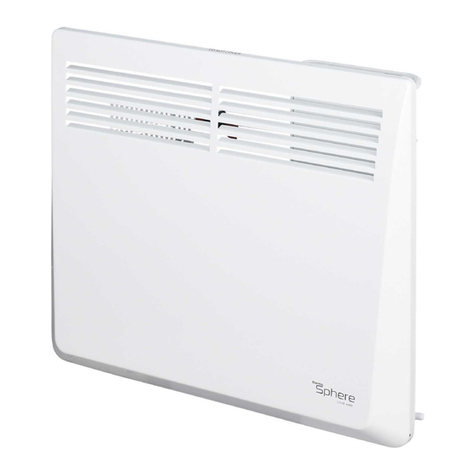
Thermo Sphere
Thermo Sphere TSCR-0500-A installation guide
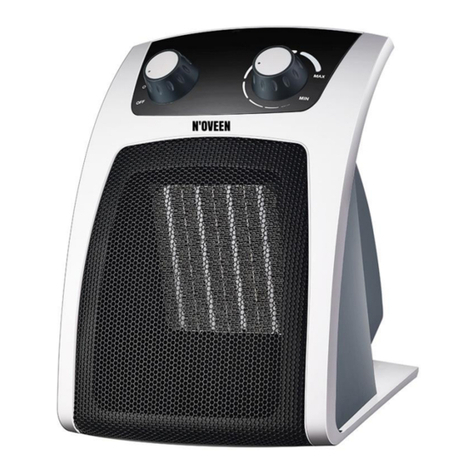
N'oveen
N'oveen PTC10 user manual
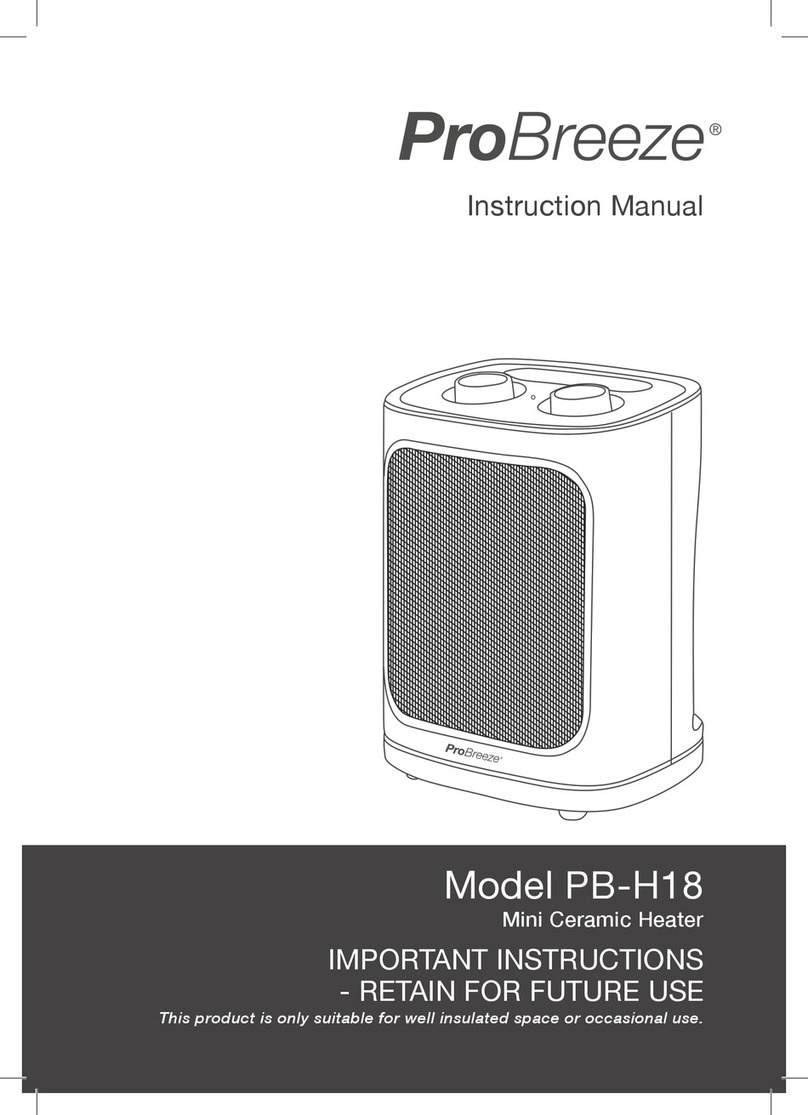
Pro Breeze
Pro Breeze PB-H18 instruction manual
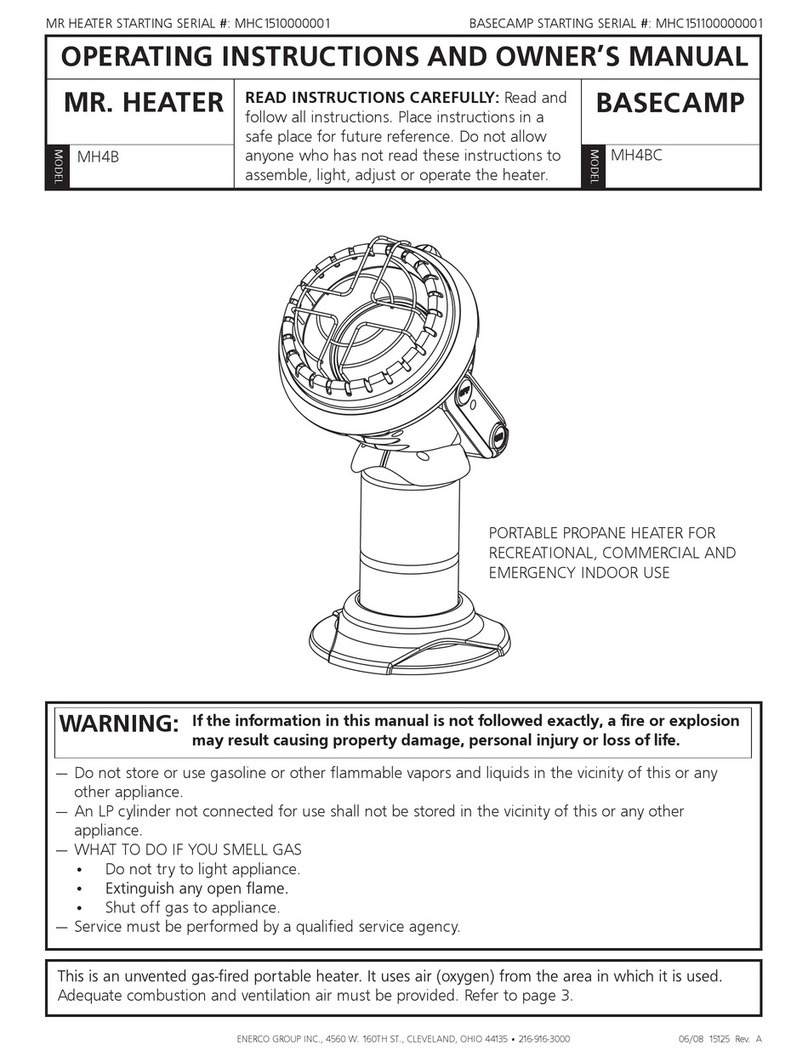
MrHeater
MrHeater MH4BC Operating instructions and owner's manual
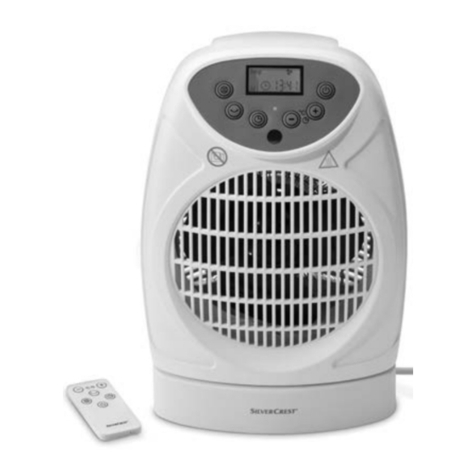
Silvercrest
Silvercrest SHLF 2000 D3 Operation and safety notes
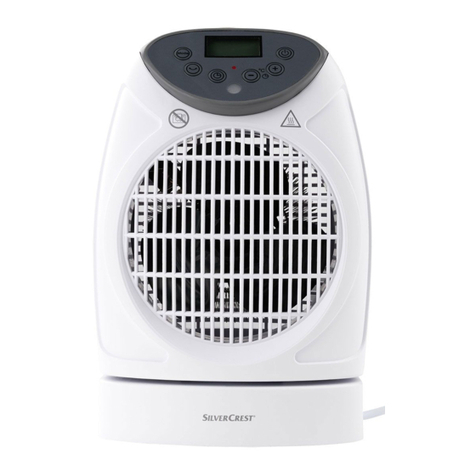
Silvercrest
Silvercrest SHLF 2000 D1 Operation and safety notes
